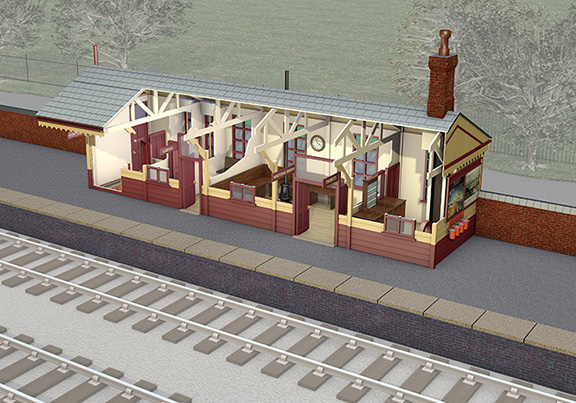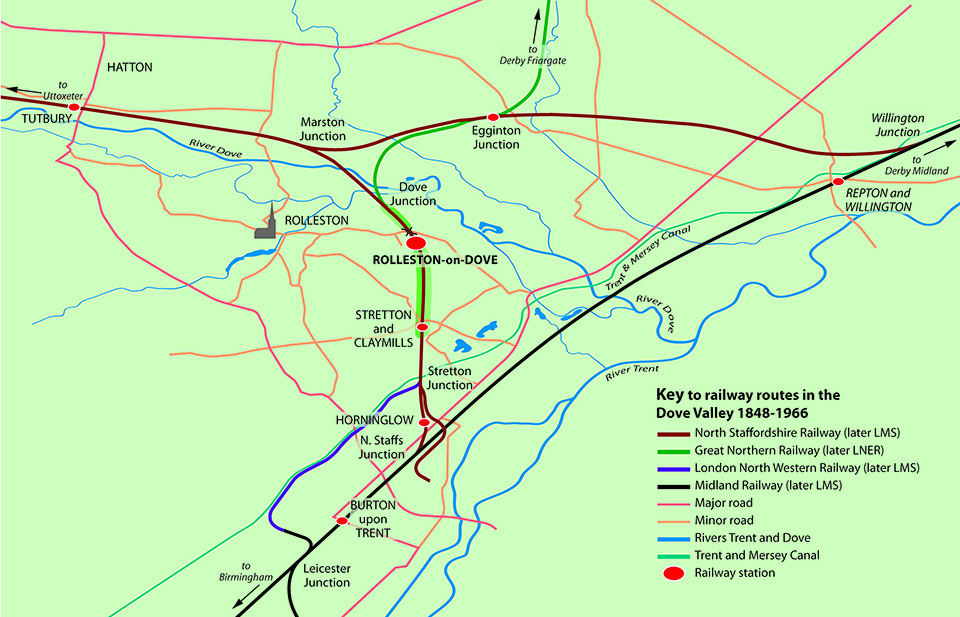A brief history:
The "Burton Branch" of the North Staffordshire Railway Company (NSR), opened 11th September 1848, linking Stoke-on-Trent with Burton upon Trent, passing through the parish of Rolleston some three miles from the route’s destination. Refreshed by ale brewed specially at a neighbouring farmhouse, believed to be what is now the "Jinny Inn", the navies completed the work, which involved the moving of many tons of earth from the high ground towards Craythorne to form an embankment across the Dove flood plane, in just a year. The new line crossed what became Station Road by an iron bridge, the third such structure is seen in the photograph; the first bridge having been washed away in a flood and replaced by a temporary wooden structure that accomodated a single track only. Running powers were granted by the Midland Railway (MR), which enabled the “Knotty”, as it was affectionately known, to enter Burton station via North Staffs Junction. Please refer to map.
In 1849 the NSR acquired powers to build a line diverging from the Burton Line at Marston Junction, to Derby via a junction with the MR to the north of Willington and to the south of Stenson Junction. This route remains operational. 1st April 1868 saw the building of the "Hawkins Lane Branch" to access the NSR and the London & North Western Railway’s (LNWR) Horninghlow Street goods yards at Burton. In later years the Great Northern Railway's Hawkins Lane goods station was also accessed by this branch. This branch left the route at Stretton Junction, which was also the junction for the LNWR’s Dallow Branch, opening 3rd July 1882.
The network in the Dove Valley, around Rolleston was completed 1st May 1878 when the Great Northern Railway (GNR) built a spur between Dove Junction and Egginton Junction, giving them a direct route between Burton upon Trent and Derby - Friargate Station.
The second image to the right, looking northwards and showing the signal cabin, can be dated circa 1949-52; the goods loop has been lifted, but the signal cabin remained until 1952. The signals are original, products of McKenzie and Holland, replaced in 1955. The approaching train is the Burton-bound Tutbury Jinny being propelled by ex MR Johnson 0-4-4 tank locomotive with ex NSR auto trailer leading.
The third image shows the footbridge that linked Craythorne Hall with Dovecliffe Hall. The rails have been lifted but the iron spans remained until the mid eighties leaving the brick piers as a reminder.
The reason for this railway development was, amongst others, to tap the lucrative traffic generated by the Burton upon Trent breweries which to date had been monopolised by the Midland Railway.
Rolleston Station was not opened until 1st November 1894. The name was soon changed to “Rolleston-on-Dove” to avoid confusion with Rolleston Junction on the Nottingham - Lincoln line. The station had two platforms, signal cabin, loop and goods dock which also handled coal, livestock and milk. The track layout was modified in 1899 to include additional pointwork at the southern end allowing easier access to the dock. It was some distance from the village at the request of the Mosley family resident at Rolleston Hall, but houses were soon built adjacent to the station, to accommodate the village’s first commuters.
Two other intermediate stations were opened along the route, Horninglow in 1883 and Stretton & Claymills in 1901. Originally Rolleston-on-Dove was the only station to have goods facilities; a loop serving a gravel dock was installed at Stretton and Claymills in 1920.

The above 3-dimensional model, has been cutaway to indicate the 4 rooms that made-up the main station building. L to R – Booking Office, Waiting Room, Ladies Room with WC and Gentlemens' WC. This image forms part of a panel to be installed at the actual site.
Link to view the panel.
Detailed Map:
To view a more detailed map indicating track layouts at Horninglow, Hawkins Lane, Stretton & Claymills and Rolleston-on-Dove, all associated with the North Staffordshire and Great Northern Railways, please apply the link below:
Link to view the map.
The fourth image showing the derelict booking hall was taken during the mid sixties when the line was still open. The fifth image, looking northwards, shows the platelayer's hut and the post 1955 BR standard signals. In the distance is Dove Junction signal cabin.
The line passed to London Midland Scottish ownership in 1924, although trains taking the GNR route operated under the London, North Eastern Railway (LNER) banner. Following nationalisation in 1947, trains ex GNR/LNER remained distinctive in appearance. On closure 1st January 1949, the loop and sidings were removed almost immediately, the signal cabin in 1952, but the booking hall and waiting shelter remained in a derelict state until the mid sixties. The line closed 6th May 1968, some five years before the author became a resident of Rolleston-on-Dove.
Dove Junction Signal Box:
The image right lower is a copy of one page of the Dove Junction signalman's record; dated August 1956, as many as 70 workings daily are entered in its columns. The complete book has been kindly donated to us for safe-keeping by the son of the late Mr Bill Wain, a photograph of him in Dove Junction signal box is below, a serving signalman at that time.

